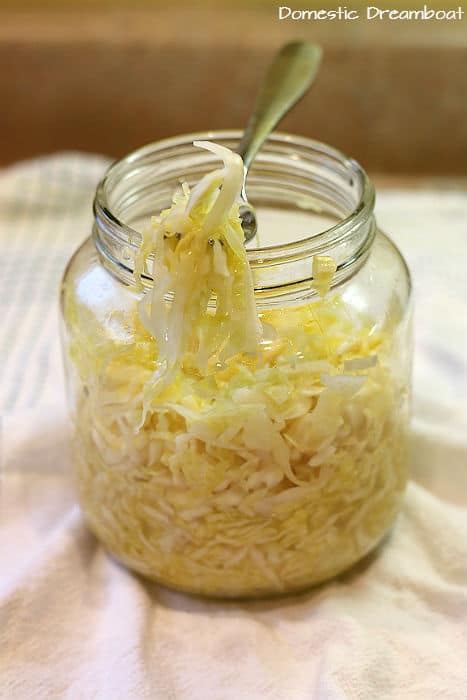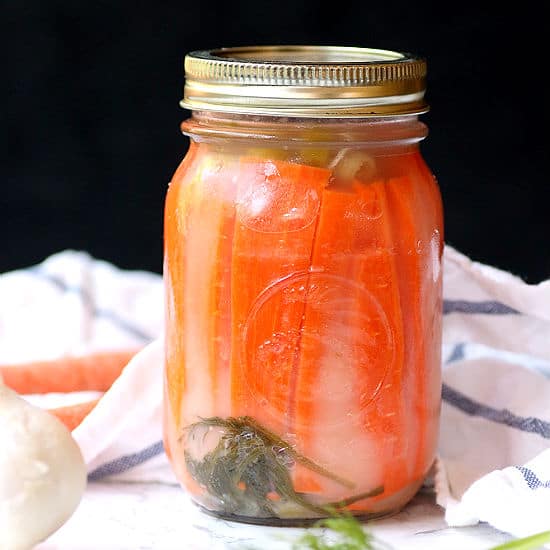Lacto Fermented Dill Pickled Carrots
Lacto-fermented pickled carrots are sour, salty, loaded with garlic and dill flavor, and contain gut-healthy probiotics.
Eating pickled carrots was a favorite treat of mine during childhood. We didn’t have them often, as I don’t think my mom made them herself. Rather, I think we may have gotten them from family members who did.
Nonetheless, I loved them. My husband did when he was a kid too, so I tried to replicate that sour, salty flavor myself for a long time. I got close with my Refrigerator Pickled Carrots, but it wasn’t quite the same.
So when I started successfully experimenting with lacto-fermenting, making pickled carrots became a high priority.

I have been making these Lacto Fermented Dill Pickled Carrots for quite some time now – at least a couple of years. I haven’t posted them sooner because I’ve never gotten a change to photograph them.
They just disappear that quickly. As soon as I decide they’re done, they start getting eaten. Sometimes, within a matter of hours they are gone. I guess that’s okay though, because at least they’re never taking up too much storage space in the fridge.

What is Lacto-Fermentation?
Lacto-fermentation is the process in which the healthy bacteria (Lactobacillus) present in certain fruits and vegetables reproduce in a salty environment to turn the sugars from the foods into lactic acid. This lactic acid acts as a preservative to help kill off the bad bacteria and is what makes the pickles taste sour.
If you’ve never tried fermenting at home, this is a pretty easy way to start. There is no massaging of salt as with sauerkraut, it simply requires cutting up some carrots, throwing in some dill and garlic, and covering it all with salty brine. Given time, the lactobacillus bacteria that are naturally present begin to sour the carrots and brine, slowly turning them into pickles.
Food Fermentation Safety
Of course, with any fermentation project, food safety is key. Make sure you clean your work surfaces, jars, and hands very well before you start, and check your fermenting pickles daily for any signs of mold. If you see any, you will have to discard the jar and start over.
The key to avoiding this is to keep everything completely submerged in the brine. This can be accomplished using glass weights and specially designed silicone lids, that are made specifically for food fermentation.
The weights keep the vegetables submerged and protected in the brine, and the lids are vented to allow any built-up gas and pressure to escape while preventing possible contaminants from entering the jar.
Want more Fermented Food recipes?
Lacto Fermented Dill Pickled Carrots Nutrition Notes
Calculating nutrition info for pickles is difficult, as just calculating the recipe as written assumes that you will use all the brine, and that you will consume all the brine. Most people don’t drink pickle brine (except for me, when I was pregnant).
Anyway, keep in mind that the sodium content that you get out of this pickles depends on how much brine you actually use, and how much of it you actually consume. Otherwise, you’re basically just eating carrot sticks – a low-calorie, high-fiber snack.
Equipment
Ingredients
Instructions
- Stir together 1 Tablespoon kosher salt and 4 cups filtered or distilled water until the salt is completely dissolved. Set aside.
- Place 1 crushed garlic clove and 4 sprigs of dill in the bottoms of 2 quart sized jars. Pack the carrot sticks into the jars as tightly as you can. I find the best way to do this is to pack them vertically in 2 layers, making sure to leave some space at the top of the jar for the brine. The tighter you pack them in, the better, as it will help keep them in place when they are fermenting.
- Pour the brine into the jars. You may have some leftover, which could be used to make more pickles. If any of your carrots are floating up in the brine, use something to keep them submerged. It could be something edible, like a cabbage leaf, or a small upturned glass container. I use glass weights that are specially designed for fermenting.
- Cover the top of the jar with a few layers of cheesecloth, a few coffee filters or a clean cotton dish towel secured tightly with an elastic band. Move to a dark space where they won't be disturbed (like a pantry). Check on them daily to make sure no carrots or dill is floating above the brine, which will cause mold problems. If floating does occur, use a weight to push everything down.
- After a few days, you may see the brine begin to get cloudy. This is a normal part of the pickling process. Some pickles will get cloudier than others due to water content. After about a week, start tasting the pickles. They will begin to taste sour. The longer you leave them, the more sour they will become. When they have reached a flavor that you like, remove the weight (if used) and replace the cloth on top with the lid, and place in the refrigerator. They will keep in there for about a month.
Nutrition
Tried this recipe?
Please Consider Leaving a Review!



